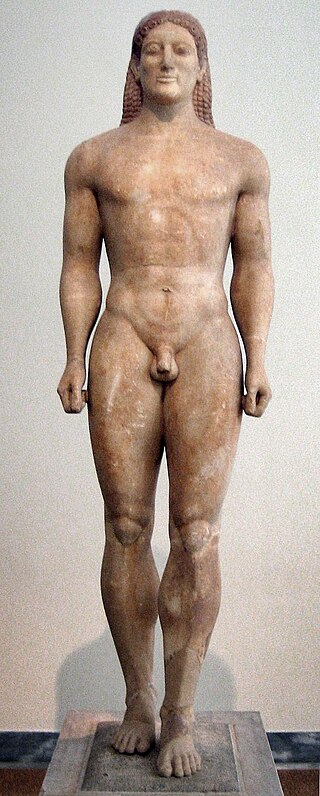
Kouros is the modern term given to free-standing Ancient Greek sculptures that depict nude male youths. They first appear in the Archaic period in Greece and are prominent in Attica and Boeotia, with a less frequent presence in many other Ancient Greek territories such as Sicily. Such statues are found across the Greek-speaking world; the preponderance of these were found in sanctuaries of Apollo with more than one hundred from the sanctuary of Apollo Ptoion, Boeotia, alone. These free-standing sculptures were typically marble, but the form is also rendered in limestone, wood, bronze, ivory and terracotta. They are typically life-sized, though early colossal examples are up to 3 meters tall.
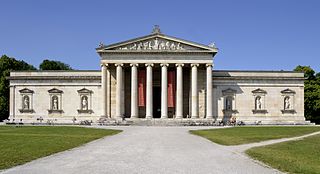
The Glyptothek is a museum in Munich, Germany, which was commissioned by the Bavarian King Ludwig I to house his collection of Greek and Roman sculptures. It was designed by Leo von Klenze in the neoclassical style, and built from 1816 to 1830. Today the museum is a part of the Kunstareal.

The sculpture of ancient Greece is the main surviving type of fine ancient Greek art as, with the exception of painted ancient Greek pottery, almost no ancient Greek painting survives. Modern scholarship identifies three major stages in monumental sculpture in bronze and stone: the Archaic, Classical and Hellenistic. At all periods there were great numbers of Greek terracotta figurines and small sculptures in metal and other materials.

The archaic smile was used by sculptors in Archaic Greece, especially in the second quarter of the 6th century BCE, possibly to suggest that their subject was alive and infused with a sense of well-being. One of the most famous examples of the archaic smile is the Kroisos Kouros, and the Peplos Kore is another.

The life-size ancient but much restored marble statue known as the Barberini Faun, Fauno Barberini or Drunken Satyr is now in the Glyptothek in Munich, Germany. A faun is the Roman equivalent of a Greek satyr. In Greek mythology, satyrs were human-like male woodland spirits with several animal features, often a goat-like tail, hooves, ears, or horns. Satyrs attended Dionysus.

Tenea is a municipal unit within the municipality of Corinth, Corinthia, Peloponnese, Greece. The municipal unit has an area of 167.575 km2 (64.701 sq mi). Until 2011, it was a municipality whose seat was in Chiliomodi.
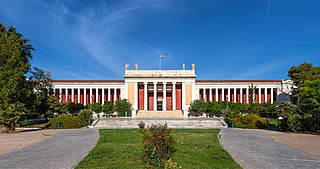
The National Archaeological Museum in Athens houses some of the most important artifacts from a variety of archaeological locations around Greece from prehistory to late antiquity. It is considered one of the greatest museums in the world and contains the richest collection of Greek Antiquity artifacts worldwide. It is situated in the Exarcheia area in central Athens between Epirus Street, Bouboulinas Street and Tositsas Street while its entrance is on the Patission Street adjacent to the historical building of the Athens Polytechnic university.

Classical sculpture refers generally to sculpture from Ancient Greece and Ancient Rome, as well as the Hellenized and Romanized civilizations under their rule or influence, from about 500 BC to around 200 AD. It may also refer more precisely a period within Ancient Greek sculpture from around 500 BC to the onset of the Hellenistic style around 323 BC, in this case usually given a capital "C". The term "classical" is also widely used for a stylistic tendency in later sculpture, not restricted to works in a Neoclassical or classical style.

The so-called Blond Kouros's Head of the Acropolis is the head of a lost marble statue of a young man of ca 480 BC, in the Acropolis Museum in Athens, Greece. The head and part of the pelvis were found in 1923 northeast of the museum site on the Acropolis of Athens. It belongs to the late archaic or early classical period. The curly hair points more to the Archaic than the Classical period.

The Apollo of Piombino or the Piombino Boy is a famous Greek bronze statuette in late Archaic style that depicts the god as a kouros or youth, or it may be a worshipper bringing an offering. The bronze is inlaid with copper for the boy's lips, eyebrows, and nipples. The eyes, which are missing, were of another material, perhaps bone or ivory.
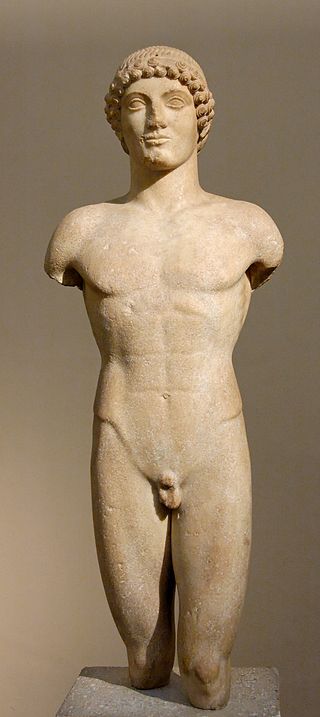
The Strangford Apollo is an ancient Greek sculpture of a nude boy, with the arms and lower legs missing. It dates to around 490 BC, making it one of the latest examples of the kouros type of statue, and is made of Parian marble. The sculpture has been in British Museum's collection since 1864, when the museum acquired it from the collection of Percy Smythe, 8th Viscount Strangford.
The large, grave statue of a youth from Attica known as the Munich Kouros is located in the Glyptothek in Munich, Germany, under inventory number 169. The Kouros was acquired by the Glyptothek in 1910.

The Archaeological Museum of Delos is a museum on the island of Delos, near Mykonos in the South Aegean, Greece. It is noted for its extensive collection of statues unearthed in the surrounding area of the ancient site, which has been declared a UNESCO World Heritage Site. Although the museum has a considerable collection, it does not contain all of the items found in Delos: a large quantity are on display in Athens at the National Archaeological Museum.

The Getty kouros is an over-life-sized statue in the form of a late archaic Greek kouros. The dolomitic marble sculpture was bought by the J. Paul Getty Museum, Los Angeles, California, in 1985 for ten million dollars and first exhibited there in October 1986.
Kouros is a type of Ancient Greek sculpture, which represents a naked male youth.
Apellai, was a three-day family-festival of the Northwest Greeks similar with the Ionic Apaturia, which was dedicated to Apollo . The fest was spread in Greece by the Dorians as it is proved by the use of the month Apellaios, in various Dorian states.
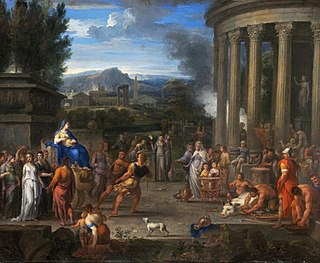
Kleobis (Cleobis) and Biton are two Archaic Greek Kouros brothers from Argos, whose stories date back to about 580 BCE. Two statues, discovered in Delphi, represent them.

Gods in Color or Gods in Colour (original title in German: Bunte Götter – Die Farbigkeit antiker Skulptur is a travelling exhibition of varying format and extent that has been shown in multiple cities worldwide. Its subject is ancient polychromy, i.e. the original, brightly painted, appearance of ancient sculpture and architecture.
The Sounion Kouros is an early archaic Greek statue of a naked young man or kouros carved in marble from the island of Naxos around 600 BCE. It is one of the earliest examples that scholars have of the kouros-type which functioned as votive offerings to gods or demi-gods, and were dedicated to heroes. Found near the Temple of Poseidon at Cape Sounion, this kouros was found badly damaged and heavily weathered. It was restored to its original height of 3.05 meters (10.0 ft) returning it to its larger than life size. It is now held by the National Archaeological Museum of Athens.

The Kouros of Apollonas, also called the Colossus of Dionysus, is a 10.7 metre tall unfinished statue of light grey Naxian marble with a weight of around 80 tonnes. It is located in an ancient quarry near Apollonas, a small town in the northern part of Naxos, one of the Cycladic Islands in the Aegean Sea. The statue is a kouros dating from Archaic period of Ancient Greece, around the turn of the seventh and sixth centuries BC.
















